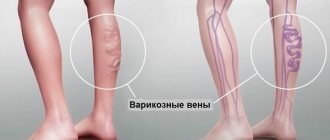Varicose veins of the penis are most often associated with a hereditary predisposition. This disease involves an enlargement of the veins on the penis by more than 6 mm. The disease is very unpleasant and can result in impotence, therefore, if you notice signs of varicose veins, you need to urgently make an appointment with a urologist.
Signs of varicose veins of the penis
The content of the article
The first signs of varicose veins on the penis are practically invisible. With the development of pathology, unpleasant sensations in the penis will be felt during sexual intercourse and urination:
- Due to the constant pressure of blood in the veins on the organ, the man experiences frequent urination, accompanied by unpleasant pain.
- Painful, pinching, tingling sensations in the penis during and without an erection.
- With varicose veins, pain can also occur during sexual intercourse, and especially during ejaculation.
- Swellings and veins twisting into knots and enlarged in size appear on the penis; abnormal swelling and associated redness can be noted. The formations can be easily felt when touching the penis.
If the disease is not treated, the veins increase in volume so much that huge lumps may appear on the penis itself, the number and size of which increases, causing pain to the patient. Vein anomalies become especially noticeable during an erection.
Diagnostics
Diagnosis of the disease begins with examination of the penis, collection of anamnesis and patient complaints. Based on the size of the veins and their number, the doctor can predict the development of this pathology. In rare cases, to confirm or refute the diagnosis, patients are prescribed to undergo Doppler examination of the veins or venography with the introduction of a contrast agent.
Men should visit a phlebologist or urologist if they have:
- A vein on the penis swelled up, it became large, hard, blue, deformed,
- Venous nodules appeared under the skin,
- The veins have become painful and hypersensitive,
- The skin of the penis has become bluish or dark red,
- Pain and tingling sensations appeared during sexual intercourse.
The doctor examines the penis and determines whether varicose veins are present. Patients often require consultation with a urologist, dermatologist or surgeon.
Complications
If swelling on the penis does not cause inconvenience and does not cause pain, it may be just a temporary deformation of the muscles and tendons of the penis, characteristic of male physiology, and not varicose veins.
But in any case, you need to see a urologist, since an advanced state of penile varicose veins can result in rupture of the veins during the next erection and internal or external hemorrhage. Such an ending, in the worst case, will lead to the complete loss of the functionality of the penis and complete impotence, and in the “best” - to infertility.
Preventive measures
Treatment of vascular diseases is a long process. They can be warned not to face the consequences. The main methods of preventing varicose veins of the penis are:
- Complete nutrition. A healthy diet is fundamental to normal blood circulation. It is necessary to avoid fatty, fried and salty foods. You should limit your intake of foods high in cholesterol to prevent the formation of atherosclerotic plaques on the walls of blood vessels, obstructing blood flow. The diet must include vegetables, fruits, whole grain cereals, and protein. Dishes are best cooked in the oven or steamed.
- Rejection of bad habits. Alcohol and smoking, in addition to a serious blow to the cardiovascular system, have a negative effect on intracellular metabolism. The vessels are not saturated with the necessary substances, their walls become thinner, resulting in the development of varicose veins.
- During treatment for STDs, it is necessary to take medications to prevent varicose veins.
- Moderate loads. It is worth giving up strength sports and, if possible, limiting heavy physical labor. It is necessary to walk regularly and perform exercises that stimulate blood circulation.
- Cold and hot shower. It helps stimulate blood flow in the problem area.
- Refusal to visit baths, saunas, and hot baths. Exposure to high temperatures can negatively affect the functioning of the blood vessels of the penis.
- Limiting medications that help prolong sexual intercourse. If possible, it is better to avoid them altogether, because they not only increase the likelihood of developing varicose veins of the penis, but are also addictive.
- Regular sex life. The optimal frequency of ejaculation for a man of reproductive age is 2-3 times a week.
If you have varicose veins of the penis, you should not self-medicate. If a problem exists and you are bothered by unpleasant symptoms, first consult a doctor.
Still have questions about penile varicose veins?
Free consultation with AngioClinic specialists
Author
Salmina Daria Vladimirovna
Geneticist. Graduated from the Chelyabinsk State Medical Academy. She completed an internship at the Northwestern State Medical University named after I.I. Mechnikov.
The main reasons for the development of varicose veins
Varicose veins on the penis do not appear on their own. Knowing the reasons, you can protect yourself from unpleasant consequences. Usually the reason for the development of varicose veins in the veins of the penis are:
- Injuries during physical or sports training, blows delivered directly to the groin area.
- Improper functioning of the genitourinary system due to bladder diseases.
- Unsuccessful penile surgery associated with other diseases.
- Sexual life leading to constant changes of partners and infection with infectious diseases that cause swelling and inflammation in the genital area.
- The use of drugs that cause instant erection of the penis, arousal and abuse of alcohol and tobacco.
- Prolonged, exhausting sexual intercourse.
Prevention
Preventive measures to avoid such problems and strengthen the general condition of the body:
- Stimulation of blood flow - self-massage, contrast shower,
- Walking barefoot on the water,
- Regular sex life
- Proper nutrition,
- Taking vitamins A, C and E,
- Avoiding medications that prolong sexual intercourse
- Use of contraceptives in the absence of a regular partner,
- Caution towards non-traditional sexual methods,
- Wearing properly fitted underwear,
- Sports activities,
- Avoiding hot baths.
Enlarged veins on the penis do not threaten the patient’s life, but have a negative impact on sexual life. To avoid the development of dangerous complications, you should consult a doctor when the first signs of pathology appear.
Diagnosis of the disease
First of all, to confirm the diagnosis, the urologist will do an ultrasound of the penis with a Doppler sensor - Doppler sonography. This will help accurately determine the stage of the disease and the presence or absence of blood clots in the swollen veins of the penis. Doppler measurements are carried out during an artificially induced erection, during which the condition of the vascular wall and the level of blood stagnation in the veins are thoroughly examined.
Additionally, the doctor will examine in detail the prostate and the entire scrotum using ultrasound - this is done with a conventional sensor. The examination is not painful or dangerous.
If varicose veins of the genital organ have gone far, you need to examine the entire pelvis. It is possible that the cause of the pathology lies in other organs.
Diagnosis of the disease
There is a clear algorithm for diagnosing varicose veins of the penis. First of all, the doctor conducts a visual examination and listens to the patient’s complaints. It is also necessary to undergo the following examinations:
- Ultrasound of the penis with Doppler to assess the blood supply to the organ and analyze the condition of the vessels;
- Phlebography – is prescribed if there is a suspicion that varicose veins have affected the deep veins.
The patient must undergo general urine and blood tests, and a spermogram. This will help eliminate the infectious nature of the lesion.
Treatment of varicose veins
If you seek help from a urologist before penile varicose veins reach a severe stage, you can avoid surgery and undergo vein treatment on an outpatient basis. The patient is prescribed medications based on herbal infusions in the form of ointments and gels, ointments that improve blood circulation and strengthen the walls of blood vessels. They have a warming effect and disperse blood stagnation in the veins, significantly expanding and then constricting the vessels. If varicose veins of the penis are advanced, immediate surgical intervention under local or general anesthesia will be required. Most often, gentle techniques are used - such procedures are carried out directly in the clinic.
Surgical treatment is carried out using different methods:
- Percutaneous embolization . To control manipulations, X-ray technology is used that supplies normalized radiation. The impact leads to occlusion (narrowing) of the varicose vein without using a scalpel. Disadvantage of embolization - possible side effects caused by X-ray radiation.
- Classic surgical operation . The urologist makes a skin incision over the testicular vein. The dilated vessel is pulled in two places, blocking the blood flow. After this, the affected part of the vein is cut off. The outflow of blood after surgery occurs through healthy vessels.
- Microsurgical ligation . If the veins of the spermatic cord are clearly visible, a low-traumatic intervention is performed. The affected vein is operated on through a mini-access. Naturally, recovery after the procedure is faster than after conventional surgery.
- Laparoscopic surgery . To access the veins, a laparoscope is used - a device with a mini-camera and lighting. The operation is monitored through a computer monitor, so damage to the lymph nodes and testicular artery is excluded.
The urologist decides which method to treat genital varicose veins. The doctor first of all takes into account the degree of development of the pathology and the extent of the process.
Removal of the dorsal (deep dorsal) vein of the penis
We have already written in detail about erectile dysfunction and the causative factors that can lead to this type of disorder ( here... ). In this article we will talk in more detail about the tactics of surgical correction of the venous form of erectile dysfunction.
The venogenic form occurs against the background of normal blood flow to the penis. There is no shortage of blood supply; the arteries through which blood flows to the tissues of the penis function adequately. However, the dilated veins carry out a pathologically rapid discharge of blood, which is why an erection, even if it occurs, is for a short period of time. Morning erections are either very sluggish and practically unnoticeable, or do not appear at all. At the same time, desire and sexual desire in patients are preserved. All this has an extremely negative impact on the quality of life, the quality of sexual life in particular.
Treatment of venogenic form of erectile dysfunction
The most effective method of treating this form of erectile dysfunction is surgical tactics, namely, removal of the dorsal vein of the penis . The dorsal vein is the main vessel through which the main discharge of blood from the tissues of the penis occurs. By removing this vessel, we eliminate the main duct through which blood “runs away” from the penis.
Technically, the operation consists of access through a subcoronal incision of the skin and underlying penile membranes (identical to the incision when performing circumcision of the foreskin of the penis), then the skin and membranes are shifted to the base of the penis. The stage of isolating and ligating the vein is carried out using special surgical instruments. After this, step-by-step suturing of the area of the removed vein, membranes and skin of the penis is carried out. A compression bandage is applied. In order to prevent postoperative complications (suppuration, paraphimosis), the foreskin must be removed.
It is the removal, and not the ligation, of the vein that is fundamentally important, since only when the vein is removed do we also resect its collaterals (circumflex veins). Removing the vein along its entire length significantly increases the effectiveness of the surgical procedure. Speaking about the effectiveness of the operation, it should be noted that erectile function improves in almost all operated patients, however, the duration and preservation of the achieved effect is extremely variable. In our practice, there were patients who forgot about the problem for years, there are also those who returned after 6-8 months with renewed complaints.
What determines the success of the operation to remove the dorsal vein, you ask?
From the technique of removing the dorsal vein of the penis in the first place. The vein should be removed rather than ligated; this significantly increases the effectiveness of the surgical procedure. We can qualitatively influence this important factor by performing the operation at a high professional level, with the hands of a specialist with extensive experience in performing this type of surgical treatment.
Then why do patients sometimes also return to you, specialists who perform removal of the entire length of the dorsal vein of the penis?
Let us explain that, unfortunately, it is currently almost impossible to predict the influence of a hereditary factor on the prognosis of the disease. Violations of the rigidity of the vein walls are often a systemic disease of the whole organism, the degree of its progression and development is genetically determined. At the same time, modern medicine can only partially influence the progression of systemic disease of the venous bed of the body, such as insufficiency of the venous wall.
Another alternative for treating venous erectile dysfunction is penile prosthesis. However, this technique involves the complete destruction of the corpora cavernosa of the penis, followed by the installation of artificial implants in their place. Based on this, in the treatment of the venogenic form of erectile dysfunction, penile replacement is considered as a third-line treatment method.
Diagnosis of the venogenic form of erectile dysfunction
Let us recall that the main method for diagnosing erectile dysfunction is Doppler examination of the vessels of the penis with a pharmacological load. This method allows you to identify vascular disorders in both the arterial and venous systems. The first stage is to assess the state of the vascular bed at rest, after which the specialist administers the drug into the cavernous bodies of the penis. Against the background of artificial erection, ultrasound and Dopplerography of the vessels of the penis are repeated, and after analyzing the data obtained, a specialist gives a conclusion. Only after a comprehensive assessment of the results obtained can one judge the presence and form of vascular disorders that led to a deterioration in erectile function in a man. A Doppler study can reliably identify dysfunction of the venous and arterial beds of the penis; only after this study, based on the data obtained, the issue of further treatment tactics is decided.
MAKE AN APPOINTMENT ONLINE ASK YOUR DOCTOR OUR CONTACTS
Tags: varicose veins of the penis veins of the penis Consultation with an andrologist Moscow Consultation with a uroandrologist Moscow treatment of venogenic erectile dysfunction Moscow Erectile dysfunction ligation of the veins of the penis penis vein removal of the veins of the penis removal of the vein of the penis removal of the deep dorsal vein of the penis removal of the deep dorsal vein of the penis removal of the dorsal vein of the penis removal of the dorsal vein of the penis
Prevention of genital diseases, including varicose veins
- Scheduled examination by a urologist
. Starting from adolescence, a man should be examined by a male doctor once a year. Having reached 45 years of age, visit a urologist every six months: at this age dangerous diseases appear - prostatitis, adenoma and prostate cancer. - Unscheduled consultation
. Make an appointment with your doctor if you notice any discharge from the genitals, rashes, itching, pain when urinating, increased frequency of urination, or changes in urine volume. These signs can indicate serious illnesses, many of which are quite easy to treat at the very beginning. - Diagnostics
. If you are sexually active, get tested regularly for sexually transmitted infections. You also need to take tests every six months if you have chronic diseases of the reproductive system, tumors, condylomas, or pathologies of the male organs. - Treatment
. Follow all doctor's recommendations. If the doctor recommends removal of the tumor or another radical treatment method, carry it out without delay! - Prevention
. When planning to conceive a child, contact a urologist and undergo all the necessary examinations. Remember that all sexually transmitted infections are a path to infertility or the birth of a sick baby. Do not forget that you need to treat STDs at the same time as your spouse.
Attention! At the first signs of decreased libido, impotence, or accelerated ejaculation, make an appointment and undergo examination and treatment by a urologist - this will save you from problems in your personal life.
Non-infectious causes of scarlet spots and spots on the phallus:
- Allergic reactions. They can appear both when the allergen gets inside and from local exposure. If red spots appear on the penis, you need to rule out allergies to the medications or lubricants used, latex included in the condom, or food products that have recently appeared in the diet. It is important not to wear synthetic underwear. During treatment, avoid washing powder and soap with fragrances (you can use household or children's hypoallergenic soap).
- Failure to comply with personal hygiene rules. A scarlet rash appears in those men who rarely change their underwear and wash their penis poorly or rarely.
- Decreased immunity. Stress, alcohol abuse, and the presence of chronic diseases worsen immune defense. Against this background, opportunistic flora is activated, which leads to the formation of rashes.
- Damage to the head of the phallus. During intense coitus, wearing tight underwear, riding a bicycle for long periods of time, or riding a horse for many hours, capillaries and other small blood vessels can burst. In addition, it is possible to injure the delicate skin on the head. In this case, the spots that appear do not itch, but touching the penis causes discomfort.
- Autoimmune pathologies. The most common is psoriasis. It can manifest itself in different ways, which sometimes makes diagnosis difficult. Localization of spots - in the groin, on the head or body of the penis.
- Precancerous condition. With Bowen's disease, a red-brown spot appears in the pathological area, which turns into a plaque. This lesion peels off and becomes covered with crusts that are easy to remove. When the disease progresses to oncology, an ulcer forms.
- Cancer. It is characterized by the appearance of a small malignant neoplasm of a spot that does not hurt or bleed. Gradually increases in size, becomes denser, similar to a tubercle. Purulent discharge, itching and the appearance of blood from the pathological focus are observed as the disease progresses.
As you can see, there are many reasons why red spots appear on the head of the penis or its body. And it is not recommended to diagnose yourself by looking at photos on the Internet and reading information about possible diseases; it is inappropriate. So the man will only worsen the course of the pathology, and the disease will become chronic. Remember: the sooner you start fighting the disease, the easier it is to kill the infection and achieve a complete recovery.
Symptoms
The vein swollen with varicose veins is dense and does not disappear when changing position or after a light massage. It is dilated and deformed. The walls no longer push the blood further, it stagnates and causes a feeling of heaviness, and then pain.
If a vein comes out, this does not mean varicose veins. After some time it may disappear. We can talk about varicose veins in cases where the vein is painful to touch, the skin in its area turns red, and there is a feeling of heaviness in the penis.
At the first stage of varicose veins, a man notices that the vein is swollen in a certain area, but it is soft and does not cause problems. At the second stage, the vein becomes denser, the pattern is more pronounced, there is a feeling of fullness, itching, the penis swells, and dense nodules are visible under the skin. On the third – noticeable pain, which is present almost constantly.
Treatment
After receiving and analyzing the diagnostic results, the urologist determines how to cure balanitis and relieve inflammation of the head. Treatment of balanitis begins with strict adherence to personal hygiene. It is necessary to wash the penis with soap several times a day. By adhering to this rule in the early stages of the disease, you can stop the pathological process of inflammation of the head of the penis and avoid other types of treatment.
For more serious forms of inflammation of the head in men, drug treatment is prescribed. Medicines for balanitis have an antiseptic effect. Most often, inflammation of the glans penis is treated with ointments or creams.
In addition to ointments, the doctor can also prescribe drug therapy: tablets for the treatment of balanitis in men, for example, Suprax, Azithromycin.
In rare and complicated cases, surgical treatment is used - excision of the foreskin.
Frequently asked questions about inflammation of the head of the penis
How can balanitis be dangerous?
Balanitis is dangerous, first of all, because of its complications. Complications such as gangrene and the spread of the inflammatory process to the genitourinary system pose a particular threat.
How long does it take to treat inflammation of the head?
How long to treat inflammation of the head of the penis depends on the stage of the disease, clinical manifestations and how to treat balanitis. Pathology in a simple form with proper treatment goes away in about 7 days. Treatment of balanitis is carried out on an outpatient basis, in rare cases - inpatient.
What effective remedies are there?
Ointment for inflammation of the glans penis in men is one of the most effective dosage forms, as it acts directly on the affected area. Depending on the etiology of balanitis, the ointment can be antifungal (Clotrimazole), antiseptic (Levomekol), or glucocorticoid. Antiseptic baths also have a beneficial effect. For severe forms of the disease, antibiotics are used.










